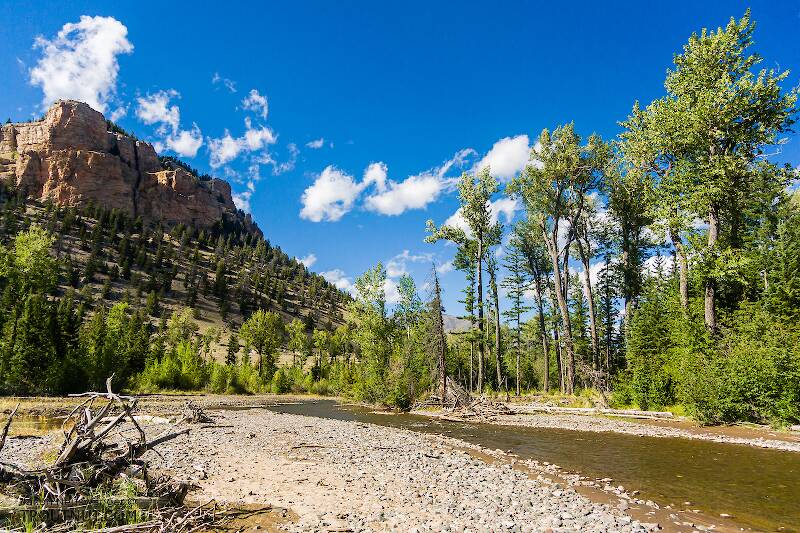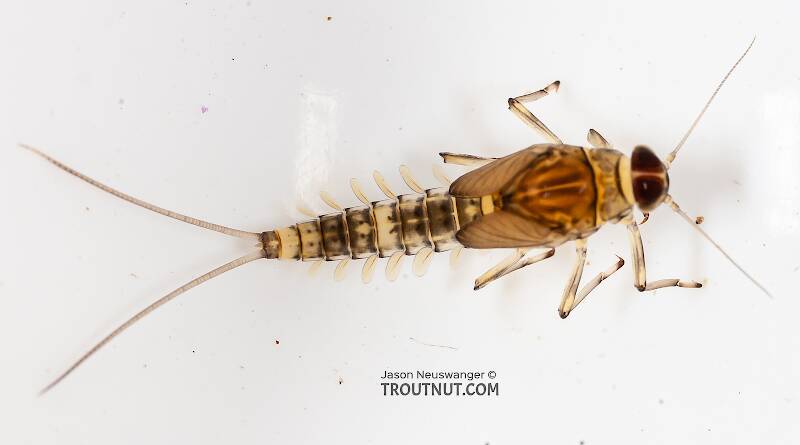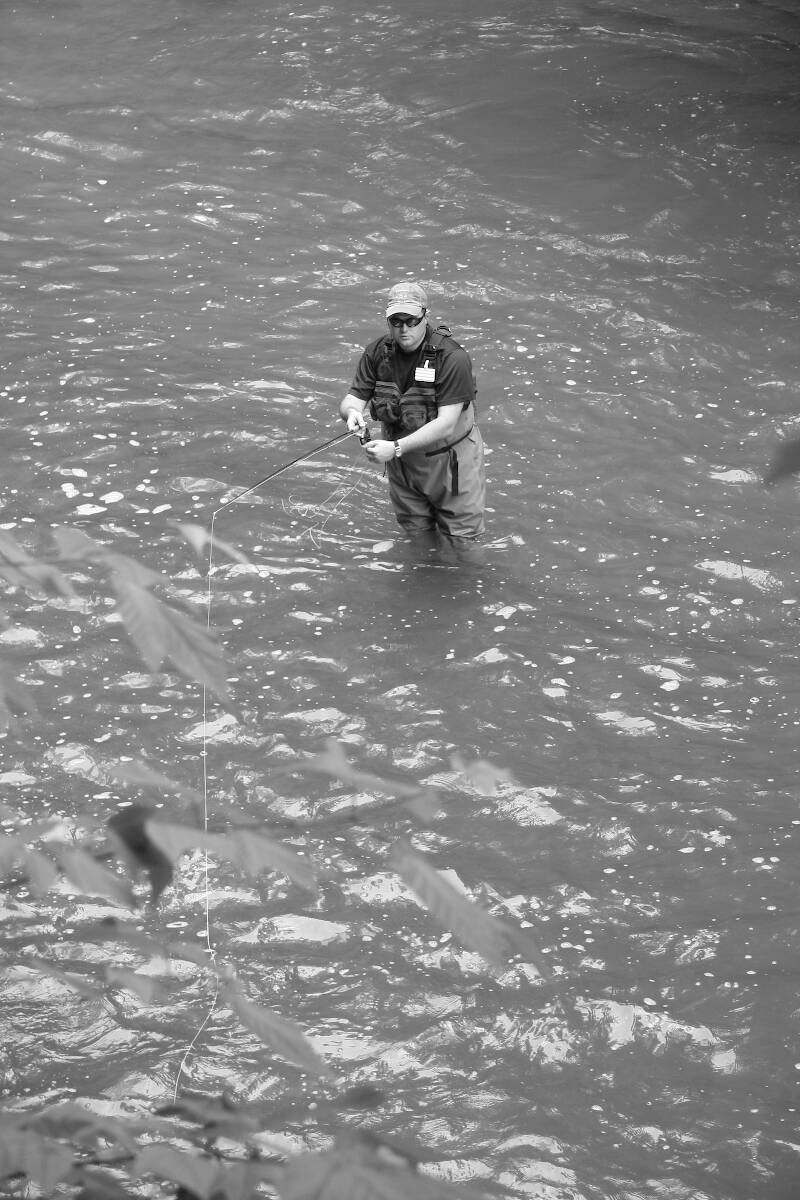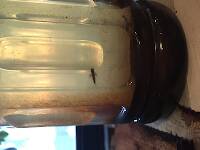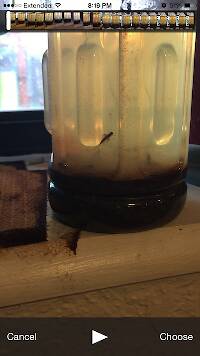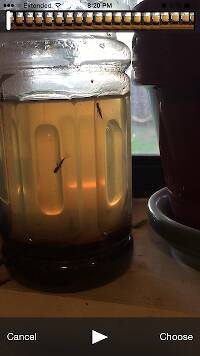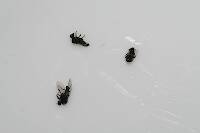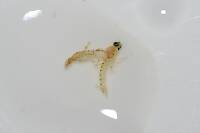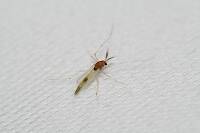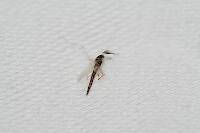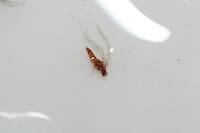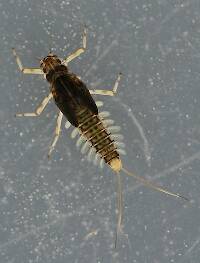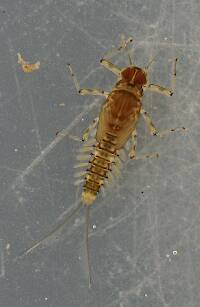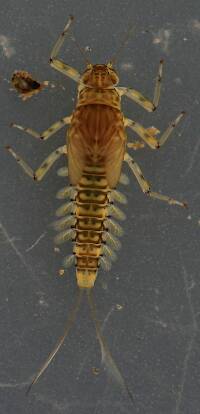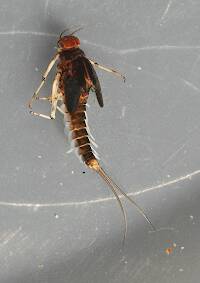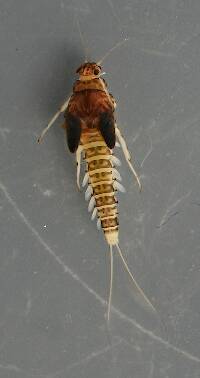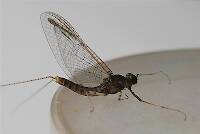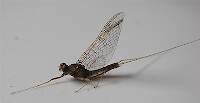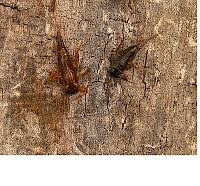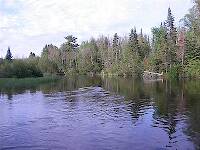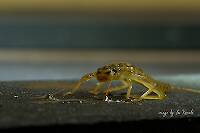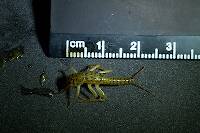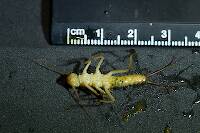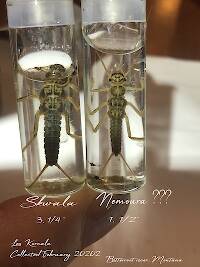
Blue-winged Olives
Baetis
Tiny Baetis mayflies are perhaps the most commonly encountered and imitated by anglers on all American trout streams due to their great abundance, widespread distribution, and trout-friendly emergence habits.
Featured on the forum

This specimen appears to be of the same species as this one collected in the same spot two months earlier. The identification of both is tentative. This one suffered some physical damage before being photographed, too, so the colors aren't totally natural. I was mostly photographing it to test out some new camera setting idea, which worked really well for a couple of closeups.

Troutnut is a project started in 2003 by salmonid ecologist Jason "Troutnut" Neuswanger to help anglers and
fly tyers unabashedly embrace the entomological side of the sport. Learn more about Troutnut or
support the project for an enhanced experience here.
Troutnut on Jul 20, 2011July 20th, 2011, 12:11 am EDT
There aren't all that many baetids reported from Alaska, but I couldn't figure out what this one is. I didn't have a lot of time to look at keys, but here's the whole list of reported Alaskan baetids, with the ones I could obviously eliminate crossed out (and now some that you've eliminated, too):
Acentrella feropagus
Acentrella insignificans
Acentrella lapponica
Acentrella turbida
Baetis bicaudatus
Baetis foemina
Baetis tricaudatus
Baetis bundyae
Baetis flavistriga
Callibaetis
Diphetor hageni
Plauditus dubius
Procloeon pennulatum
Acentrella feropagus
Acentrella insignificans
Acentrella lapponica
Acentrella turbida
Baetis bicaudatus
Baetis foemina
Baetis tricaudatus
Baetis bundyae
Baetis flavistriga
Callibaetis
Diphetor hageni
Plauditus dubius
Procloeon pennulatum
Jason Neuswanger, Ph.D.
Troutnut and salmonid ecologist
Troutnut and salmonid ecologist
Konchu on Jul 20, 2011July 20th, 2011, 4:22 am EDT
save it for me, and I'll take a look. is that a broken or vestigial middle tail?
GONZO on Jul 20, 2011July 20th, 2011, 5:17 am EDT
The only thing I can say for sure is that it is a male. I think you can probably rule out Diphetor hageni and Procloeon. Acentrella should have a fringe of fine hairs on the legs. The middle tail does appear to be vestigial.
Edit: At first I thought this might be B. foemina based on the combination of the middle filament being reduced to a stub and the elongate gills. (B. bicaudatus also has the middle filament reduced to a stub, and B. bundyae should have that filament 0.5-0.8 the length of the cerci--see Morihara and McCafferty 1979.) However, closer inspection shows that this specimen does appear to have a dorsal fringe of hairs on the legs. Perhaps Acentrella?
Edit: At first I thought this might be B. foemina based on the combination of the middle filament being reduced to a stub and the elongate gills. (B. bicaudatus also has the middle filament reduced to a stub, and B. bundyae should have that filament 0.5-0.8 the length of the cerci--see Morihara and McCafferty 1979.) However, closer inspection shows that this specimen does appear to have a dorsal fringe of hairs on the legs. Perhaps Acentrella?
Taxon on Jul 20, 2011July 20th, 2011, 7:44 am EDT
==================
Query Options Chosen:
==================
Search_Type="AND"
Family="Baetidae"
USA_States="AK"
nTails="2,"
Family Scientific Name
Baetidae Acentrella insignificans
Baetidae Acentrella turbida
Baetidae Baetis bicaudatus
Total species/subspecies selected: 3
======================================
Family name: Baetidae
Scientific name: Acentrella insignificans
Previously know as: Baetis insignificans
Common name:
Locality: W
CAN Regions: FN,NW
MEX Regions: SW
USA Regions: FN,NE,NW,SW
Cent. Amer. Countries:
CAN Provinces: AB, BC, NT, SU, YU.
MEX States: CH, QT, SO
USA States: AK, AZ, CA, CO, ID, NE, NM, NV, OR, TX, WA, UT.
Habitat: small to medium sized streams
Voltinism:
Emergence (begin) date: early-May
Emergence (end) date: late-Oct
Emergence time of day:
Spinner fall time of day:
Nymph minimum length: 6 mm.
Nymph maximum length: 7 mm.
Nymph identification keys: wide pale mark on tergites 3-8, 9 & 10 mostly pale
Nymph body description:
Nymph legs:
Nymph gills: veinlets indistinct
Nymph tusks:
Nymph tails: 2,
======================================
Family name: Baetidae
Scientific name: Acentrella turbida
Previously know as: Acentrella carolina, Cloeon carolina, Pseudocloeon carolina, Pseudocloeon turbidum
Common name: Bluewinged Olive Dun, Graywinged Brown Quill, Little Slatewinged Brown Quill, Bluewinged Olive, Minute Graywinged Brown
Locality: W, E
CAN Regions: NE,NW
MEX Regions: SW
USA Regions: FN,NE,NW,SE,SW
Cent. Amer. Countries:
CAN Provinces: AB, BC, MB, NS, ON, QC, S
MEX States:
USA States: AK, AL, AR, AZ, CO, CT, GA, IA, ID, IN, KY, MA, ME, MI, MN, MO, NC, NE, NM, NY, OH, OK, OR, PA, TN, TX, UT, VA, WA, WI, WV.
Habitat:
Voltinism:
Emergence (begin) date: early-May
Emergence (end) date: late-Oct
Emergence time of day:
Spinner fall time of day:
Nymph minimum length: (W): 5 mm. (E): 4 mm.
Nymph maximum length: (W): 6 mm. (E): 5 mm.
Nymph identification keys: stout body, tergites 1-8 brown, 9 & 10 pale, each tergite with two minute dots, one on each side of mid-line
Nymph body description: pale olive w/tergites 1-8 dark olive, wing case light brown
Nymph legs: pale olive
Nymph gills:
Nymph tusks:
Nymph tails: 2, (W):pale olive (E):olive
======================================
Family name: Baetidae
Scientific name: Baetis bicaudatus
Previously know as: Baetis minimus
Common name: Bluewinged Olive, Light Rusty Spinner, Pale Olive Dun
Locality: W
CAN Regions: FN,NW
MEX Regions:
USA Regions: FN,NW,SW
Cent. Amer. Countries:
CAN Provinces: AB, BC, NT, YU.
MEX States:
USA States: AK, CA, CO, ID, MT, NE, NM, OK, OR, SD, UT, WA, WY
Habitat: medium to fast
Voltinism:
Emergence (begin) date: 1-Apr
Emergence (end) date: 30-Oct
Emergence time of day: sporadic, daylight
Spinner fall time of day: early morning & evening
Nymph minimum length: 4 mm.
Nymph maximum length: 5 mm.
Nymph identification keys: tergites 4,5,9,10 often pale
Nymph body description: medium olive brown w/tergites 1-10 pale in color, dark markings on abdominal segments 3,4,7
Nymph legs:
Nymph gills: veinlets indistinct
Nymph tusks:
Nymph tails: 2,
======================================
Query Options Chosen:
==================
Search_Type="AND"
Family="Baetidae"
USA_States="AK"
nTails="2,"
Family Scientific Name
Baetidae Acentrella insignificans
Baetidae Acentrella turbida
Baetidae Baetis bicaudatus
Total species/subspecies selected: 3
======================================
Family name: Baetidae
Scientific name: Acentrella insignificans
Previously know as: Baetis insignificans
Common name:
Locality: W
CAN Regions: FN,NW
MEX Regions: SW
USA Regions: FN,NE,NW,SW
Cent. Amer. Countries:
CAN Provinces: AB, BC, NT, SU, YU.
MEX States: CH, QT, SO
USA States: AK, AZ, CA, CO, ID, NE, NM, NV, OR, TX, WA, UT.
Habitat: small to medium sized streams
Voltinism:
Emergence (begin) date: early-May
Emergence (end) date: late-Oct
Emergence time of day:
Spinner fall time of day:
Nymph minimum length: 6 mm.
Nymph maximum length: 7 mm.
Nymph identification keys: wide pale mark on tergites 3-8, 9 & 10 mostly pale
Nymph body description:
Nymph legs:
Nymph gills: veinlets indistinct
Nymph tusks:
Nymph tails: 2,
======================================
Family name: Baetidae
Scientific name: Acentrella turbida
Previously know as: Acentrella carolina, Cloeon carolina, Pseudocloeon carolina, Pseudocloeon turbidum
Common name: Bluewinged Olive Dun, Graywinged Brown Quill, Little Slatewinged Brown Quill, Bluewinged Olive, Minute Graywinged Brown
Locality: W, E
CAN Regions: NE,NW
MEX Regions: SW
USA Regions: FN,NE,NW,SE,SW
Cent. Amer. Countries:
CAN Provinces: AB, BC, MB, NS, ON, QC, S
MEX States:
USA States: AK, AL, AR, AZ, CO, CT, GA, IA, ID, IN, KY, MA, ME, MI, MN, MO, NC, NE, NM, NY, OH, OK, OR, PA, TN, TX, UT, VA, WA, WI, WV.
Habitat:
Voltinism:
Emergence (begin) date: early-May
Emergence (end) date: late-Oct
Emergence time of day:
Spinner fall time of day:
Nymph minimum length: (W): 5 mm. (E): 4 mm.
Nymph maximum length: (W): 6 mm. (E): 5 mm.
Nymph identification keys: stout body, tergites 1-8 brown, 9 & 10 pale, each tergite with two minute dots, one on each side of mid-line
Nymph body description: pale olive w/tergites 1-8 dark olive, wing case light brown
Nymph legs: pale olive
Nymph gills:
Nymph tusks:
Nymph tails: 2, (W):pale olive (E):olive
======================================
Family name: Baetidae
Scientific name: Baetis bicaudatus
Previously know as: Baetis minimus
Common name: Bluewinged Olive, Light Rusty Spinner, Pale Olive Dun
Locality: W
CAN Regions: FN,NW
MEX Regions:
USA Regions: FN,NW,SW
Cent. Amer. Countries:
CAN Provinces: AB, BC, NT, YU.
MEX States:
USA States: AK, CA, CO, ID, MT, NE, NM, OK, OR, SD, UT, WA, WY
Habitat: medium to fast
Voltinism:
Emergence (begin) date: 1-Apr
Emergence (end) date: 30-Oct
Emergence time of day: sporadic, daylight
Spinner fall time of day: early morning & evening
Nymph minimum length: 4 mm.
Nymph maximum length: 5 mm.
Nymph identification keys: tergites 4,5,9,10 often pale
Nymph body description: medium olive brown w/tergites 1-10 pale in color, dark markings on abdominal segments 3,4,7
Nymph legs:
Nymph gills: veinlets indistinct
Nymph tusks:
Nymph tails: 2,
======================================
GONZO on Jul 20, 2011July 20th, 2011, 7:54 am EDT
Thanks, Roger. After going back and forth on this, I'm now full circle (and a bit confused, which is not unusual when I look at unfamiliar baetids). It seems that leg hairs like those found on this specimen can also be found on Baetis. The general appearance doesn't seem to fit with what I know about Acentrella; they are usually chunkier with shortened abdominal segments and broader femora (and it also seems too large). I'm back to my original guess that this might be B. foemina based on an estimate that the gills are ~2.5 times as long as wide. I'm even more eager to see what Luke can make of the specimen in hand, because I give up. :)
BTW, just to add to the confusion, the size range given in Morihara and McCafferty for B. bicaudatus is 5-7mm, Acentrella insignificans (as Baetis insignificans) is 4-6mm, and B. foemina is 4mm (though, at the time, this would have reflected a single record of specimens from Baffin Island).
BTW, just to add to the confusion, the size range given in Morihara and McCafferty for B. bicaudatus is 5-7mm, Acentrella insignificans (as Baetis insignificans) is 4-6mm, and B. foemina is 4mm (though, at the time, this would have reflected a single record of specimens from Baffin Island).
Flatstick96 on Jul 20, 2011July 20th, 2011, 8:08 am EDT
I have no idea what it is (I'm not a "bug guy"), but it looks like Shawnny's Gold Rush would imitate it pretty well...
GONZO on Jul 20, 2011July 20th, 2011, 8:40 am EDT
Agreed. ;)
Troutnut on Jul 20, 2011July 20th, 2011, 9:20 am EDT
save it for me, and I'll take a look. is that a broken or vestigial middle tail?
Got seven of them for you. I think they're all the same. The middle tail's vestigial.
Jason Neuswanger, Ph.D.
Troutnut and salmonid ecologist
Troutnut and salmonid ecologist
Troutnut on Jul 20, 2011July 20th, 2011, 9:38 am EDT
This nymph is almost exactly 6mm. Going by Roger's list of characteristics, that would be too large for Baetis bicauduatus. The tergite color pattern doesn't match either of the others, although I know that's not the most reliable characteristic. I remain stumped.
Jason Neuswanger, Ph.D.
Troutnut and salmonid ecologist
Troutnut and salmonid ecologist
Entoman on Jul 20, 2011July 20th, 2011, 11:58 am EDT
Jason,
The only common western baetid I can think of that has a vestigial tail, paired dots on the abdominal dorsum, and with clearly visible gill venation is Acentrella turbida (prev. Pseudocloeon turbidum) or Little Pale Watery. There are few western baetids with the last characteristic in my observations. Going by different colored terga is highly suspect (so what's new). The specimen seems a little longer and slimmer than normal, which could be due to variability or the "telescope" effect. It may be a little early, but the presence of small pale olivaceous duns without hind wings near the collection site is something to look for.
Edit: The "chunky" build seems to be more prevalent in specimens at the lower end of the size scale (4mm)
2nd edit: I see Roger has included this species in his list of possibles. It doesn't mention gills, but this is perhaps the easiest feature to use for differentiating it from the others.
Kurt
The only common western baetid I can think of that has a vestigial tail, paired dots on the abdominal dorsum, and with clearly visible gill venation is Acentrella turbida (prev. Pseudocloeon turbidum) or Little Pale Watery. There are few western baetids with the last characteristic in my observations. Going by different colored terga is highly suspect (so what's new). The specimen seems a little longer and slimmer than normal, which could be due to variability or the "telescope" effect. It may be a little early, but the presence of small pale olivaceous duns without hind wings near the collection site is something to look for.
Edit: The "chunky" build seems to be more prevalent in specimens at the lower end of the size scale (4mm)
2nd edit: I see Roger has included this species in his list of possibles. It doesn't mention gills, but this is perhaps the easiest feature to use for differentiating it from the others.
Kurt
"It's not that I find fishing so important, it's just that I find all other endeavors of Man equally unimportant... And not nearly as much fun!" Robert Traver, Anatomy of a Fisherman
Konchu on Jul 20, 2011July 20th, 2011, 3:35 pm EDT
Reasons it could not be Acentrella lapponica or Acentrella feropagus or even Plauditus of some flavor? They don't have the same look as Acentrella turbida or Acentrella insignificans. Admittedly, I have not looked at the photo too closely, but mostly just following discussion.
P.S. Hind wingpads or none? If present, how big are they (relative to the beast itself, not using a fisherman's rule, heh heh).
P.S. Hind wingpads or none? If present, how big are they (relative to the beast itself, not using a fisherman's rule, heh heh).
Troutnut on Jul 20, 2011July 20th, 2011, 6:15 pm EDT
There aren't any hind wingpads that I can see.
I don't think those other Acentrella species are ruled out in Roger's list -- his database just doesn't have those characteristics listed for them because they're more obscure.
I don't think those other Acentrella species are ruled out in Roger's list -- his database just doesn't have those characteristics listed for them because they're more obscure.
Jason Neuswanger, Ph.D.
Troutnut and salmonid ecologist
Troutnut and salmonid ecologist
Konchu on Jul 20, 2011July 20th, 2011, 6:44 pm EDT
There aren't any hind wingpads that I can see.
I lean towards Plauditus dubius.
Entoman on Jul 20, 2011July 20th, 2011, 6:45 pm EDT
Luke -
Jason's specimens or the other examples you gave? I'm not clear on what you meant.
In any event, I think the genus Plauditus lacks leg setae and the labial palpi look different to me. As to A. lapponica or feropagus I know nothing about their appearance. Hopefully you or somebody else can shed some light on them.
Good point about the hind wingpads or lack therof. I'm assuming the latter? Perhaps Jason can take a peek and let us know.
Regards,
Kurt
They don't have the same look as Acentrella turbida or Acentrella insignificans.
Jason's specimens or the other examples you gave? I'm not clear on what you meant.
In any event, I think the genus Plauditus lacks leg setae and the labial palpi look different to me. As to A. lapponica or feropagus I know nothing about their appearance. Hopefully you or somebody else can shed some light on them.
Good point about the hind wingpads or lack therof. I'm assuming the latter? Perhaps Jason can take a peek and let us know.
Regards,
Kurt
"It's not that I find fishing so important, it's just that I find all other endeavors of Man equally unimportant... And not nearly as much fun!" Robert Traver, Anatomy of a Fisherman
Entoman on Jul 20, 2011July 20th, 2011, 6:51 pm EDT
Jason -
Rogers list does mention the other gills and they corroborate my info that their veining is "indistinct".
Luke -
I think your suggestion as to species is "dubious" at best (sorry, couldn't help myself).:)
Rogers list does mention the other gills and they corroborate my info that their veining is "indistinct".
Luke -
I think your suggestion as to species is "dubious" at best (sorry, couldn't help myself).:)
"It's not that I find fishing so important, it's just that I find all other endeavors of Man equally unimportant... And not nearly as much fun!" Robert Traver, Anatomy of a Fisherman
Konchu on Jul 20, 2011July 20th, 2011, 6:51 pm EDT
Luke -
They don't have the same look as Acentrella turbida or Acentrella insignificans.
Jason's specimens or the other examples you gave? I'm not clear on what you meant.
Acentrella lapponica & A. feropagus present a different geschtalt than do A. turbida & A. insignificans.
I wasn't able to see the mouthparts, nor the legs, clearly enough, really to make much of a definitive ID. I'm still thinking about the ventral markings on the abdomen, though. Seems that they ought to be important.
Konchu on Jul 20, 2011July 20th, 2011, 6:58 pm EDT
If it were P. dubius, I'd expect more of a band on the tails. My dubious dabblings in this dilapidated discussion have been expunged (see strike above). The hind wing pads are very important here, as are the banding of the tails, the shape of the labial palps, the coloration of the abdomen (top & bottom) and the setation of the legs.
Entoman on Jul 20, 2011July 20th, 2011, 8:15 pm EDT
My dubious dabblings in this dilapidated discussion..
Ha ha! Not to deliberately introduce a deleterious dynamic to the discussion, I think we are deep in the dungheap until you have a chance to look at these guys up close and personal.:)
Kurt
"It's not that I find fishing so important, it's just that I find all other endeavors of Man equally unimportant... And not nearly as much fun!" Robert Traver, Anatomy of a Fisherman
GONZO on Jul 20, 2011July 20th, 2011, 8:32 pm EDT
OK, the plot thickens....If the nymph does lack hind wingpads, it seems possible to eliminate all of the remaining possibilities:
Only A. turbida and P. dubium lack hind wingpads.
However, A. turbida (like A. insignificans, which has hind wingpads) is distinguished by long, fine setae on the femora. McCafferty et al. 1994 give the length of those setae as "0.60-0.75 X the width of femora." The setae that I can find on the femora of this specimen are much shorter and rather stout.
The size given for P. dubium is about 4-5mm. All accounts that I have read mention that it has a dark crossband on the middle of the cerci, and that trait is often used as a keyed characteristic.
In addition to having hind wingpads, B. bicaudatus can probably be ruled out for other reasons, though not length. Morihara and McCafferty (1997) give the length as 5-7mm, and the Dodds original 1923 description included the description of the nymph at 6mm. The gills of bicaudatus, however, are supposed to be less than 2 X as long as wide. (The gills on this specimen appear to be ~2.5 X longer than wide.)
Determining the size for B. foemina seems to be a bit tricky. The only other description that I have seen (M & M 1997) repeats McDunnough's original 4mm length for the Baffin Island specimens. No other records (that I can find) mention size. However, McDunnough says this in his original 1936 description:
Finally, I'm a bit puzzled about A. feropagus and A. lapponica being listed as separate species. A. lapponica Bengtsson is the typus nominis of Acentrella and also a synonym (of sorts) of A. feropagus. When the latter species was identified (named) in 2000 by Alba-Tercedor & McCafferty, it was considered to be a North American variation of lapponica, and the differences (primarily shorter, stouter setae on the femora and tibiae) were said to warrant species status. The authors said this:
Something must have happened in the interim because Randolph and McCafferty's 2005 Alaska listing contains the old records of A. feropagus and new records of A. lapponica!!! (Both are from the North Slope.)
For me, this investigation has gone from confusing to downright mystifying....
Only A. turbida and P. dubium lack hind wingpads.
However, A. turbida (like A. insignificans, which has hind wingpads) is distinguished by long, fine setae on the femora. McCafferty et al. 1994 give the length of those setae as "0.60-0.75 X the width of femora." The setae that I can find on the femora of this specimen are much shorter and rather stout.
The size given for P. dubium is about 4-5mm. All accounts that I have read mention that it has a dark crossband on the middle of the cerci, and that trait is often used as a keyed characteristic.
In addition to having hind wingpads, B. bicaudatus can probably be ruled out for other reasons, though not length. Morihara and McCafferty (1997) give the length as 5-7mm, and the Dodds original 1923 description included the description of the nymph at 6mm. The gills of bicaudatus, however, are supposed to be less than 2 X as long as wide. (The gills on this specimen appear to be ~2.5 X longer than wide.)
Determining the size for B. foemina seems to be a bit tricky. The only other description that I have seen (M & M 1997) repeats McDunnough's original 4mm length for the Baffin Island specimens. No other records (that I can find) mention size. However, McDunnough says this in his original 1936 description:
It might be mentioned that a few much larger females (forewing length 8 mm) were taken by Mr. Brown at odd times sitting on the sides of buildings, but he could find no nymphs with which these could be associated; they show no characters, other than size, by which they could be separated from the balance of the specimens and I incline to think that they may represent the left-overs of an earlier cycle, occuring possibly in July.
Finally, I'm a bit puzzled about A. feropagus and A. lapponica being listed as separate species. A. lapponica Bengtsson is the typus nominis of Acentrella and also a synonym (of sorts) of A. feropagus. When the latter species was identified (named) in 2000 by Alba-Tercedor & McCafferty, it was considered to be a North American variation of lapponica, and the differences (primarily shorter, stouter setae on the femora and tibiae) were said to warrant species status. The authors said this:
We provisionally consider all materials previously identified and reported as A. lapponica in North America to be A. feropagus.
Something must have happened in the interim because Randolph and McCafferty's 2005 Alaska listing contains the old records of A. feropagus and new records of A. lapponica!!! (Both are from the North Slope.)
For me, this investigation has gone from confusing to downright mystifying....
Troutnut on Jul 20, 2011July 20th, 2011, 8:34 pm EDT
This particular specimen has deteriorated, but I put one of the other ones (from the same collection place/time, seemingly identical) under the microscope to answer a few questions here.
* The legs are definitely fringed with setae.
* Hind wing pads are present, just well-hidden under the main wing pad. They're about as long as the second abdominal segment, and seem to have a little spur.
* All the nymphs lack banding on the tails.
Hope that gets us somewhere.
* The legs are definitely fringed with setae.
* Hind wing pads are present, just well-hidden under the main wing pad. They're about as long as the second abdominal segment, and seem to have a little spur.
* All the nymphs lack banding on the tails.
Hope that gets us somewhere.
Jason Neuswanger, Ph.D.
Troutnut and salmonid ecologist
Troutnut and salmonid ecologist
Quick Reply
Related Discussions
Topic
Replies
Last Reply
Re: Best of the Forum--Most Useful and Informative Bug Threads Featured Topic
In General Discussion by Martinlf
In General Discussion by Martinlf
17
Feb 26, 2016
by Crepuscular
by Crepuscular
9
Jun 13, 2008
by Wiflyfisher
by Wiflyfisher
2
Feb 24, 2020
by Leskorcala
by Leskorcala

